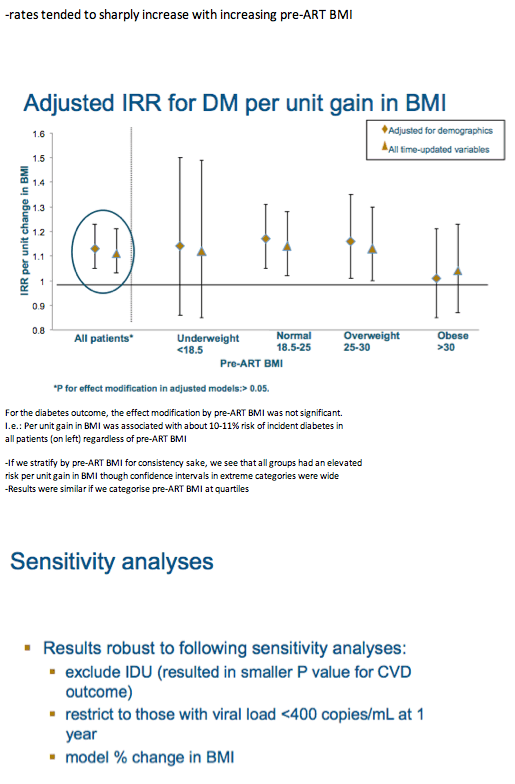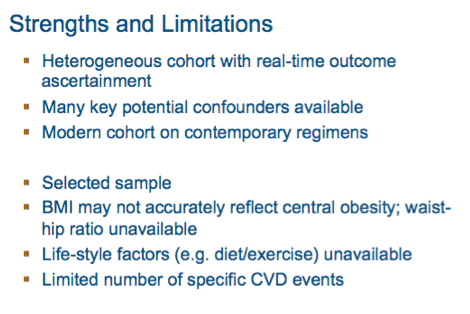 |
 |
 |
| |
Higher One-Year Risk of CVD or Diabetes Per BMI Unit Gained on ART
|
| |
| |
20th International AIDS Conference, July 20-25, 2014, Melbourne
Mark Mascolini
People starting their first antiretroviral therapy (ART) regimen with a normal body mass index (BMI) ran a significantly higher risk of cardiovascular disease (CVD) or diabetes with each BMI unit gained in the first year of treatment [1]. This D:A:D cohort analysis also found that people overweight when starting ART ran a significantly higher risk of diabetes with each BMI unit gained in the first year of ART.
Weight gain after people start ART often represents a healthy response to therapy. But gaining too much weight can boost the risk of CVD or diabetes. Because risk of heart disease or diabetes may vary with weight gain according to pre-ART BMI bracket, D:A:D investigators conducted this study of cohort members starting ART and with a BMI measure in the 12 months before and after starting therapy. They excluded people who already had CVD or diabetes and divided the study group into those who were initially underweight (BMI below 18.5 kg/m2), normal weight (BMI 18.5 to 25), overweight (BMI 25 to 30), and obese (BMI over 30). The D:A:D team used Poisson regression models to assess CVD and diabetes risk per 1-year gain in BMI according to BMI category when ART began. These models adjusted for calendar year and established CVD and diabetes risk factors, time-updated when possible.
The study group included 9321 people, 6% initially underweight, 64% normal weight, 23% overweight, and 6% obese. Three quarters of cohort members were men, about one third were white, and half reported sex between men as their HIV transmission risk. The proportion of overweight or obese cohort member rose from 29.6% before ART began to 35.5% during ART.
Among 9321 cohort members, CVD developed in 97 (1.0%) during follow-up for an incidence of 2.21 per 1000 person-years (meaning about 2 of every 1000 people got heart disease every year). CVD incidence was lowest in people underweight before starting ART (1.73 per 1000 person-years) and higher in initially normal-weight people (2.13), initially overweight people (2.41), and initially obese people (2.78).
CVD risk per BMI unit gained in the first year of ART proved highest in the initially normal-weight group (incidence rate ratio [IRR] 1.18, 95% confidence interval [CI] 1.04 to 1.32, P = 0.010). In contrast, BMI unit gained did not significantly affect CVD risk in people underweight at baseline (IRR 0.92, 0.54 to 1.56, P = 0.792), people overweight at baseline people (IRR 0.80, 95% CI 0.62 to 1.02, P = 0.070). or people obese at baseline (IRR 1.08, 95% CI 0.71 to 1.64, P = 0.714). When the D:A:D team divided participants into quartiles reflecting pre-ART BMI, people in the middle two quartiles (20.9 to 23.0 kg/m2 and 23.0 to 25.5 kg/m2) ran a higher CVD risk per each BMI unit gained in 1 year, but those in the lowest and highest quartiles did not.
Among 9193 people in the diabetes analysis, diabetes developed in 125 (1.4%) for an incidence of 2.89 per 1000 person-years. Incidence was lowest in initially underweight people (2.04 per 1000 person-years) and normal-weight people (2.01), and higher in initially overweight people (4.05) and initially obese people (9.97).
Cohort members with normal BMI before starting ART had about a 20% higher risk of diabetes with each BMI unit gained in the first year of ART (IRR 1.19, 95% CI 1.06 to 1.33, P = 0.003), as did people overweight before ART (IRR 1.22, 95% CI 1.06 to 1.40, P = 0.006). Each unit higher BMI did not significantly affect diabetes risk in people underweight at baseline (IRR 1.16, 95% CI 0.88 to 1.53, P = 0.296) or people obese at baseline (IRR 1.01, 95% CI 0.85 to 1.2, P = 0.941). In all participants considered together, each BMI unit increase in the first year of ART raised diabetes risk 10% to 11%.
The D:A:D investigators concluded that short-term gains in BMI after people start ART may be linked to a higher risk of cardiovascular disease, mainly in people with normal and midlevel BMI before ART. They suggested that the lack of a link between BMI gain and cardiovascular disease in people with a high pre-ART BMI may reflect low statistical power because of the smaller size of these groups, bias, or limitations in the cardiovascular predictive power of BMI. The researchers urged caution in interpreting these findings. They suggested that BMI gains are associated with diabetes risk in all groups studied.
Reference
1. Achhra AC, Mocroft A, Reiss P, et al. Impact of short-term change in body mass index (BMI) after antiretroviral therapy (ART) initiation on subsequent risk of cardiovascular disease (CVD) and diabetes in HIV-positive individuals: the D:A:D study. AIDS 2014. 20th International AIDS Conference. July 20-25, 2014. Melbourne. Abstract WEAB0103.
------------------



For this analysis, we selected the sub-set of D:A:D patients who (i) were known to be ART-naïve at cohort entry and started ART at some point in the follow-up; (ii) and had BMI measurements available at ART initiation (closest measured within last 365 days before ART initiation)- called pre-ART BMI (n=11615), and at one year after initiation of ART (closest measured within ±180 days)- called post-ART BMI (n=9438); (iii) had at least 6 months subsequent follow-up. We excluded patients who were known to have developed CVD or DM (for respective analyses) before 1 year post-ART time-point.







|
| |
|
 |
 |
|
|